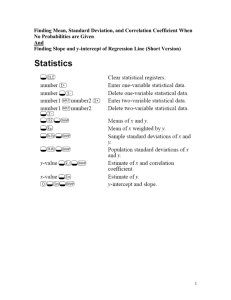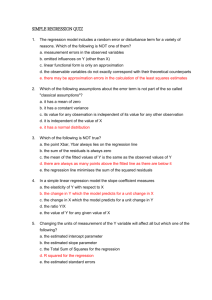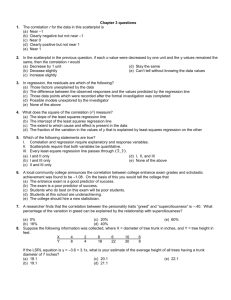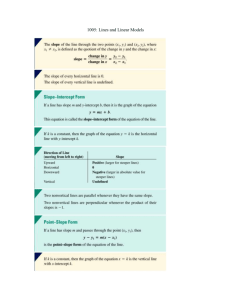Statistics MINITAB
advertisement
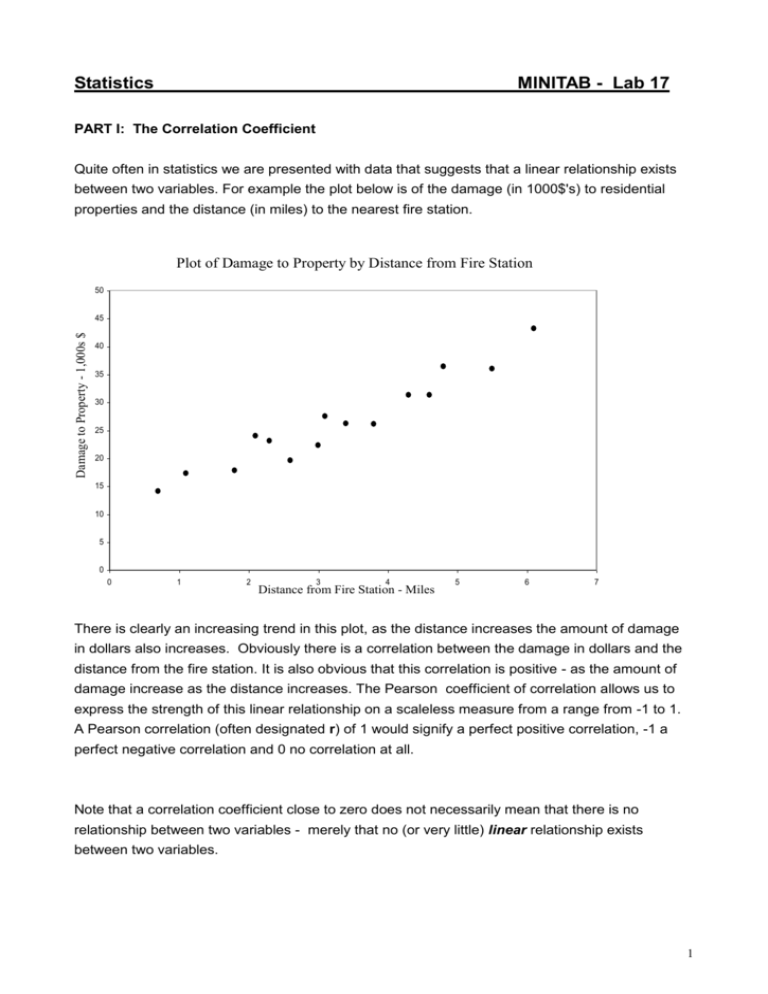
Statistics MINITAB - Lab 17 PART I: The Correlation Coefficient Quite often in statistics we are presented with data that suggests that a linear relationship exists between two variables. For example the plot below is of the damage (in 1000$'s) to residential properties and the distance (in miles) to the nearest fire station. Plot of Damage to Property by Distance from Fire Station 50 Damage to Property - 1,000s $ 45 40 35 30 25 20 15 10 5 0 0 1 2 3 4 Distance from Fire Station - Miles 5 6 7 There is clearly an increasing trend in this plot, as the distance increases the amount of damage in dollars also increases. Obviously there is a correlation between the damage in dollars and the distance from the fire station. It is also obvious that this correlation is positive - as the amount of damage increase as the distance increases. The Pearson coefficient of correlation allows us to express the strength of this linear relationship on a scaleless measure from a range from -1 to 1. A Pearson correlation (often designated r) of 1 would signify a perfect positive correlation, -1 a perfect negative correlation and 0 no correlation at all. Note that a correlation coefficient close to zero does not necessarily mean that there is no relationship between two variables - merely that no (or very little) linear relationship exists between two variables. 1 Summary from Lecture Notes The Pearson product movement coefficient of correlation, r, is a measure of the strength of the linear relationship between two variables x and y. It is computed (for a sample of n measurements on x and y) as follows: SS xy r Where SS xy xi yi SS xx xi2 SS xx SS yy x y i x i n 2 i n y y n 2 SS yy 2 i i The data shown in the plot above is available on the class library as firedamage.MTW. Open this data set and get the correlation coefficient. Go to Stat > Basic Statistics > Correlation... and select 'Distance' and 'Damage - $s' as the two variables, then click OK. What is the correlation coefficient ? ______________________ In statistics were are interested is using a sample correlation coefficient to estimate the population correlation coefficient. This involves getting a standard error for the correlation coefficient estimate and perhaps conducting tests of hypotheses. However as the correlation coefficient is essentially part of simple linear regression we will do this in Part II of this lab. PART II: 1. Simple Linear Regression In simple linear regression we attempt to model a linear relationship between two variables with a straight line and make statistical inferences concerning that linear model. We are assuming here that the variable on the x axis (the distance from the fire station) will predict the amount of fire damage caused to the house. In this case therefore, distance from the fire station is the predictor variable and the damage to the property is the response variable. 2 2. Fitting the Line Still using the dataset 'firedamage.mtw', create a plot the data .Go to Graph > Plot... and select 'Damage - $' as the y variable and 'Distance' as the x variable, click OK. When fitting a straight line model we fit what is called the least squares line. This is a straight line such that the vertical distance between the points and the line is kept at a minimum. An equation for a straight line model has two components, the intercept and the slope. Therefore the equation of the least squares line takes the form, Intercept + slope(predictor variable) + (the error or residual term) or more generally: 0 + 1(predictor variable) + , where 0 is the intercept and 1 is the slope of the line. is the distance between the fitted line and the data point, and it is the square of this quantity that we minimise using the method of least squares. Summary From Lecture Notes The formulae for the estimates of the slope and the intercept are; SS xy Slope: ̂ 1 Where SS xy x x y SS xx x ˆ 0 y ˆ1 x Intercept: SS x i i y x y i i x y i i n x n 2 n 3. i x 2 xi2 i = sample size Statistical Inference The fitting of the least squares line is essentially mathematical and of itself does not have any stocastic (i.e. statistical) content. However from a statistical point of view the fitting of the least squares line is a statistical modelling exercise. We are attempting to estimate the true linear relationship (i.e. in the population) from sample data. It is possible therefore that the apparent linear trend seen in the plot is a result of sampling variation and does not reflect an actual linear relationship between the two variables in the population. Therefore we must conduct an hypothesis test to compare the amount of variation in the data explained by the linear model with 3 an estimate of background or sampling variation. The approach taken is broadly similar to that of ANOVA and indeed an ANOVA table is constructed for this purpose. The Hypothesis being tested in this ANOVA is (in the case of simple linear regression) that the slope of the line = 0, versus an alternative that the slope of the line is not = 0. Ho: 1 = 0 Ha: 1 0 And is distributed as F with 1, and n-2 degrees of freedom. 4. Fitting A Regression Model in MINITAB Go to Stat > Regression > Fitted Line Plot... 1. Select the response variable here 2. Select the predictor variable here 3. Ensure that the linear model is selcted This command will given you a plot of the response versus the predictor with the least squares line shown on the plot, the least squares regression equation will be displayed over the plot as well as s. If you look at the session window you will also see the ANOVA table for this model and the associated p value. What is the least squares regression equation ? ___________________________________ Is the relationship between distance and damage positive or negative ? ________________ Summarise the hypothesis that is being tested in the ANOVA table, include the Ho, Ha, set = .01, the test statistic, the p value and state your conclusion. 4 5. Standard Error of the Slope We can calculate a standard error of the slope using the s which is our estimate of . This will allow us to test hypotheses about the slope (more general test than that contained within the ANOVA table) and also allow us to get a confidence interval for the slope. Summary from Lecture Notes The standard error of the slope is ˆ 1 SS xx which is estimated as s ̂ 1 s SS xx A hypothesis test for the slope One-Tailed test Two-Tailed test Ho: 1 = 10 Ha: 1 < 10 (or 1 > 10) Ho: 1 = 10 Ha: 1 10 Test statistic: t ˆ1 10 s ˆ ˆ1 10 s 1 SS xx Rejection Region: One-Tailed test Two-tailed test t < -t (or t < t ) | t | > t/2 where t and t/2 are based on (n-2) degrees of freedom. Assumptions: Same assumptions as in previous summary box. Go to Stat > Regression > Regression... 1. Select the response variable 2. Select the predictor variable 5 What is the standard error of the slope ? __________________________ MINITAB by default tests the two-tailed null hypothesis that the slope is zero. Report the results of this hypothesis test in the usual way (use = .01). Calculate the square root of the F test statistic from the ANOVA table. What is the result ? ______________ What do notice when you compare this value to the value of the t test statistic for testing the slope is zero ? __________________________________ 6 The Coefficient of Determination - R2 How much of the total sample variability around y is explained by the linear relationship between x and y ? The answer to this is given by the Coefficient of Determination or R2. The Coefficient of determination is the ratio between the total variation in the data and variation 'explained' by the linear relationship between the predictor and response variables. Coefficient of Determination - R2 R2 = SS regression / SS Total What is R2 for the regression model fitted above ? _____________________ Note, that in the case of a simple linear regression model the coefficient of determination is the correlation coefficient squared. Calculate the square root of R2 and compare it to the correlation coefficient computed in part I. 6 7 Confidence Interval for the Slope A confidence interval for the slope may be obtained by using the estimated standard error of the slope and an appropriate quantile from the t distribution with n-2 degrees of freedom. Summary From Lecture Notes ˆ1 t / 2 S ˆ 1 where the estimated standard error of ̂ 1 is calculated by S ̂ 1 s SS xx and t/2 is based on (n-2) degrees of freedom. Assumptions: Where is defined as yi yˆ i , 1. The mean of the probability distribution of is 0. 2. The variance of the probability distribution of is equal at all values of the predictor variable x. 3. The probability distribution of is normal. 4. The values of associated with any tow values of y are independent. Using the standard error from part 5, and either the INVCDF command or the Cambridge tables to get the appropriate quantile form the t distribution to calculate the 99% confidence interval for the slope: What is the confidence interval? (________________ to ________________) REVISION SUMMARY After this lab you should be able to : - Calculate the correlation coefficient by hand and in Minitab - Fit a simple linear regression line to data using Minitab - Understand the hypothesis in the simple linear regression ANOVA table - Test if the slope of the model is equal to zero or not - Construct a confidence interval for the slope 7
